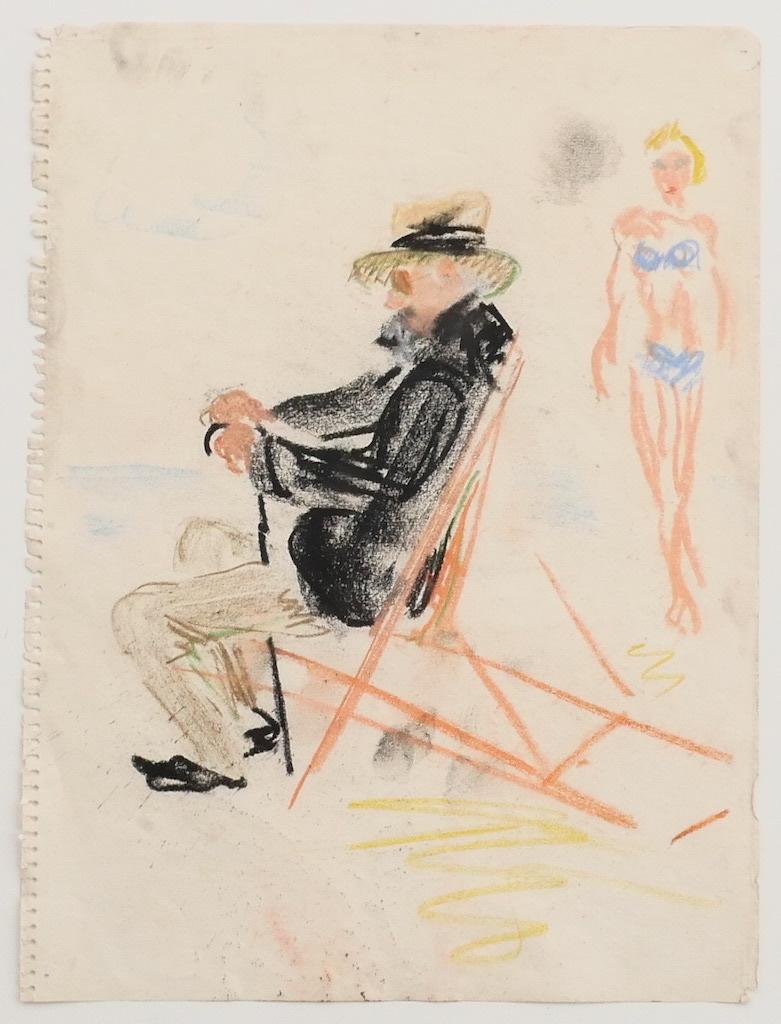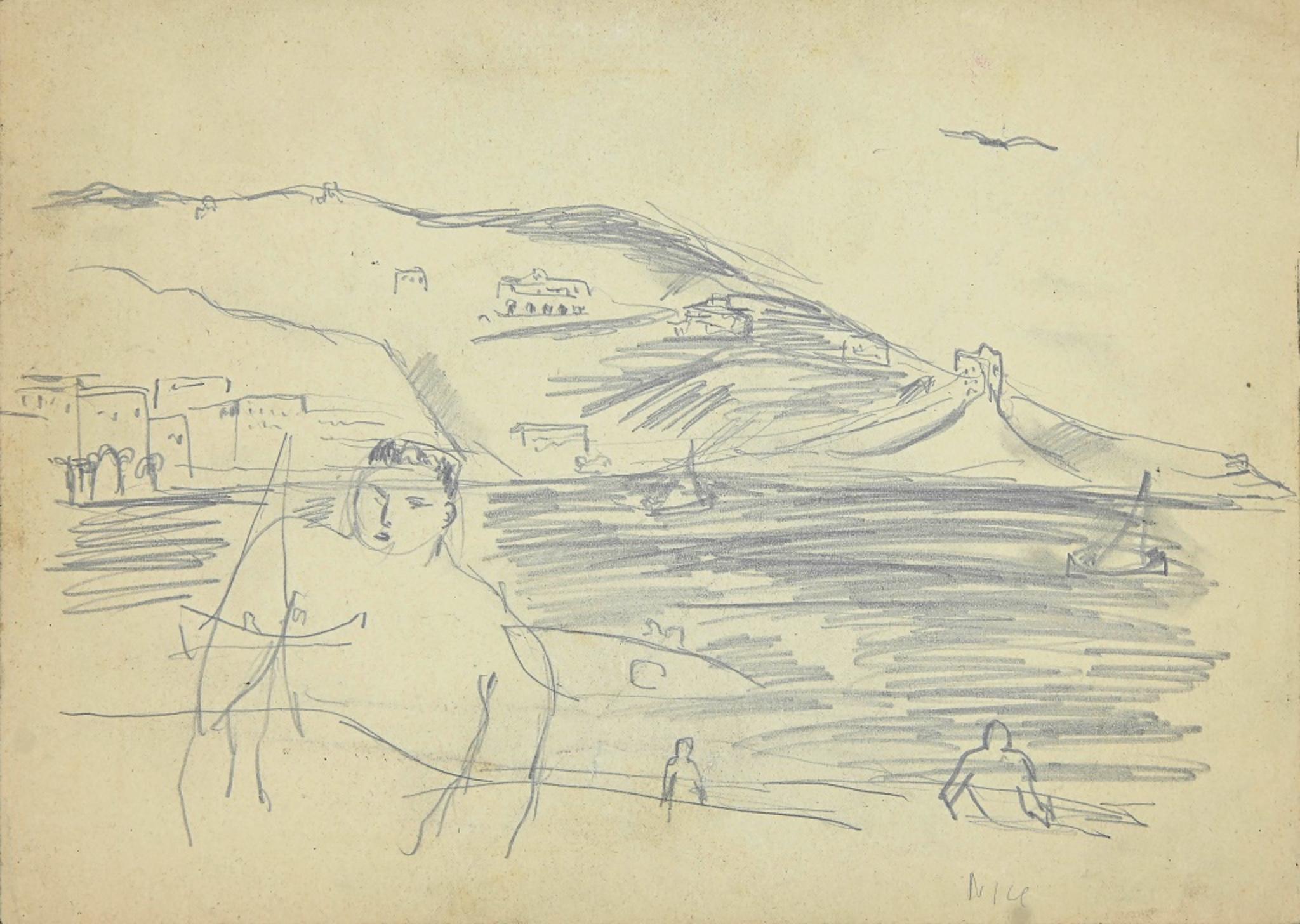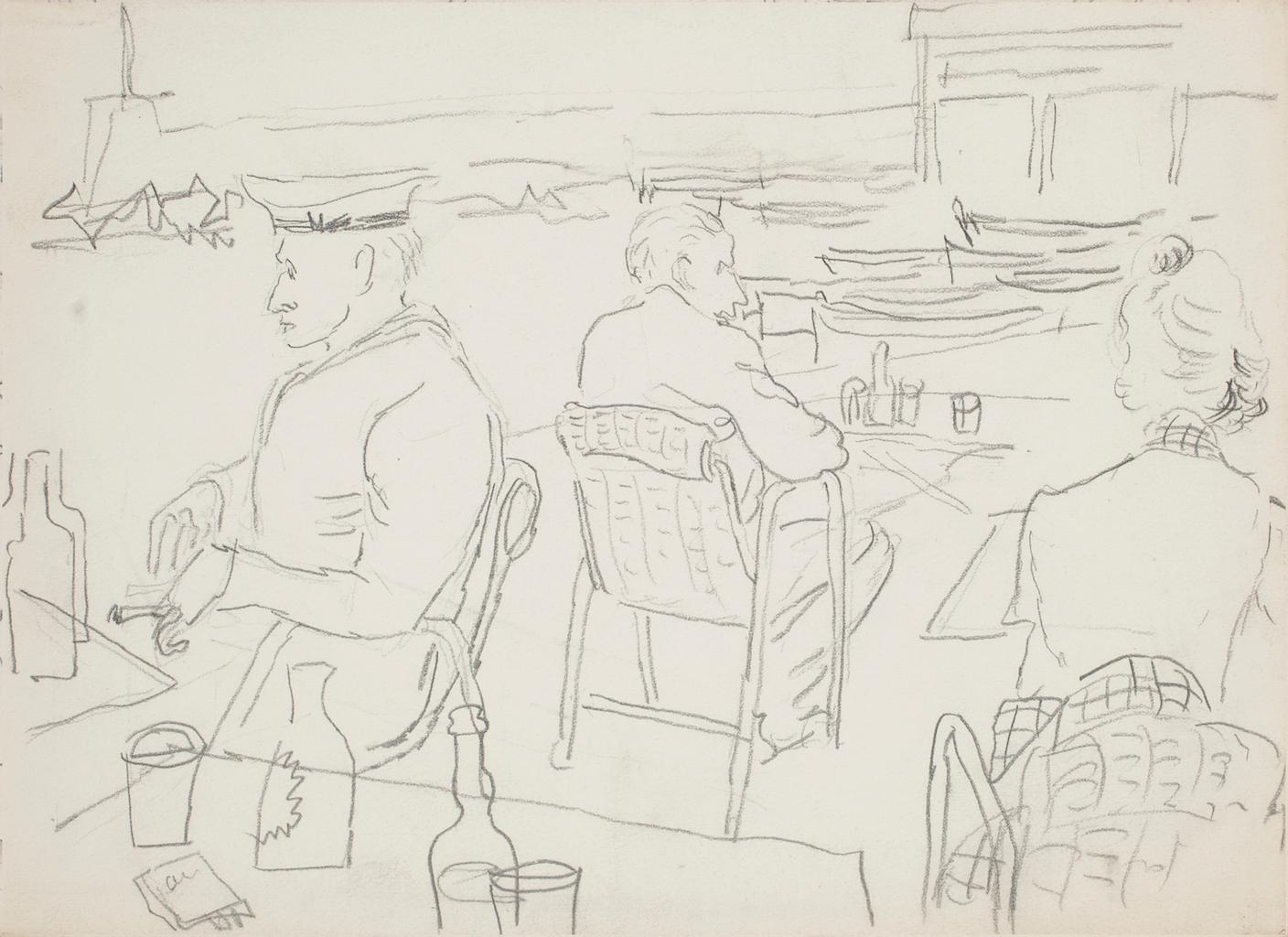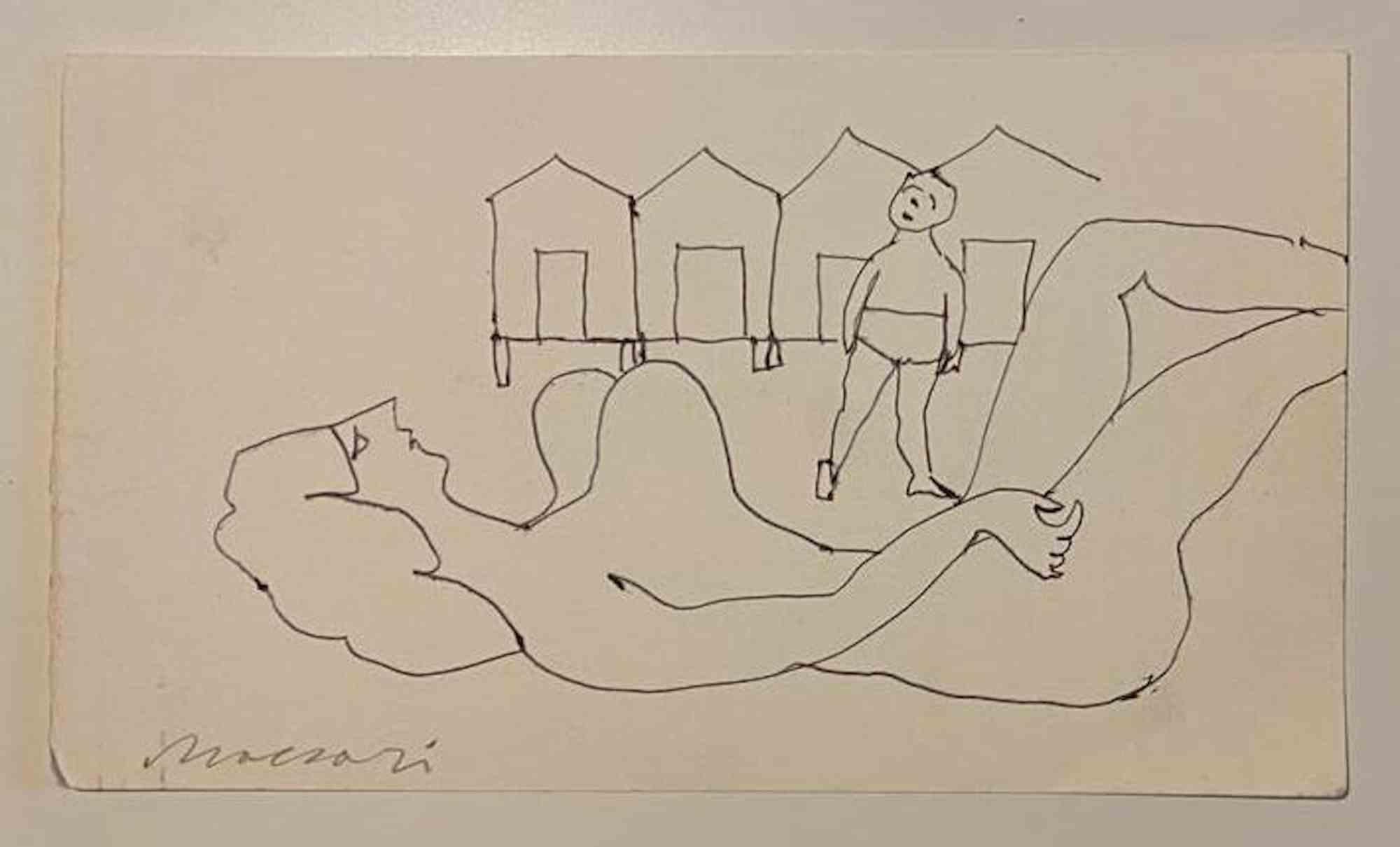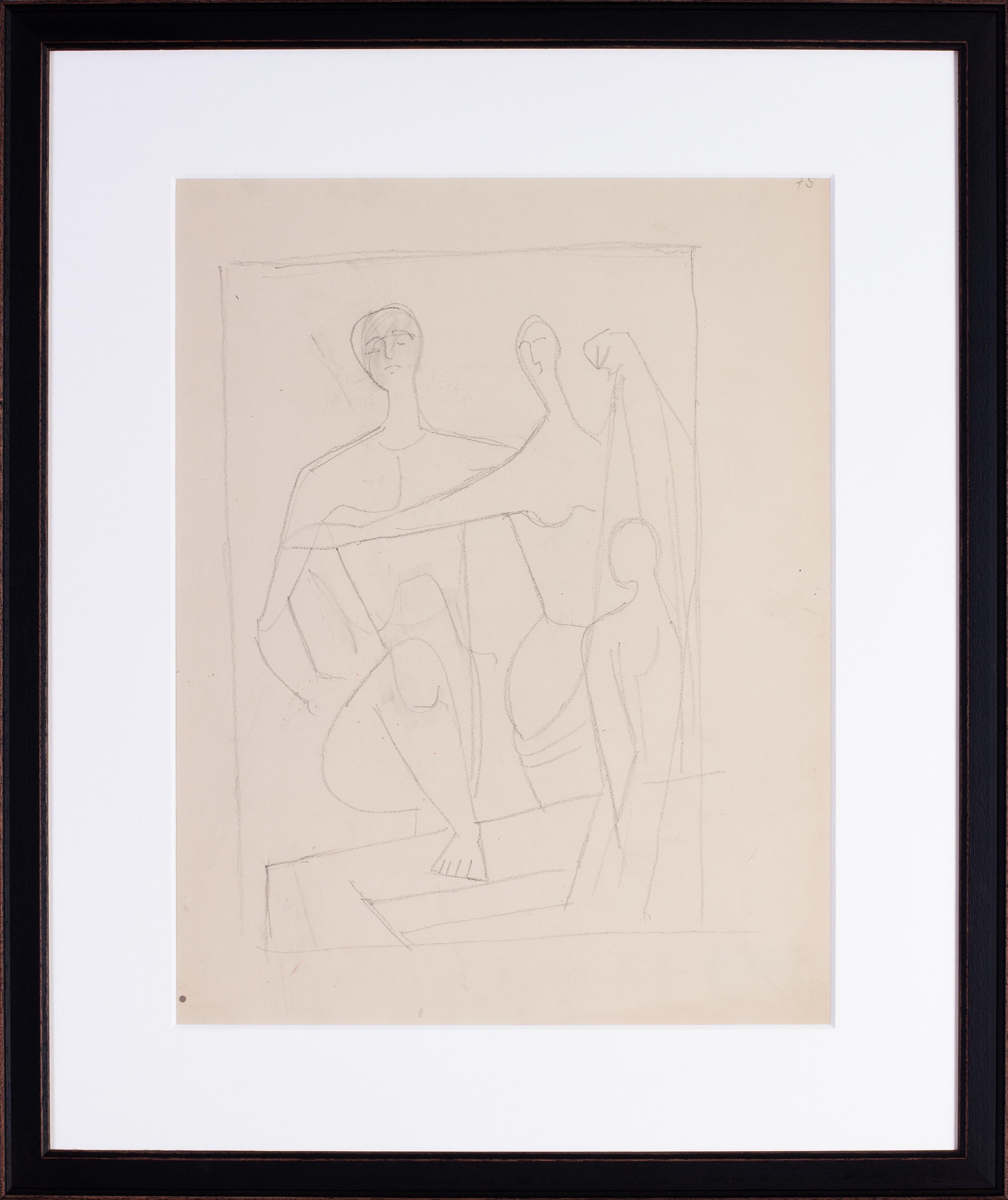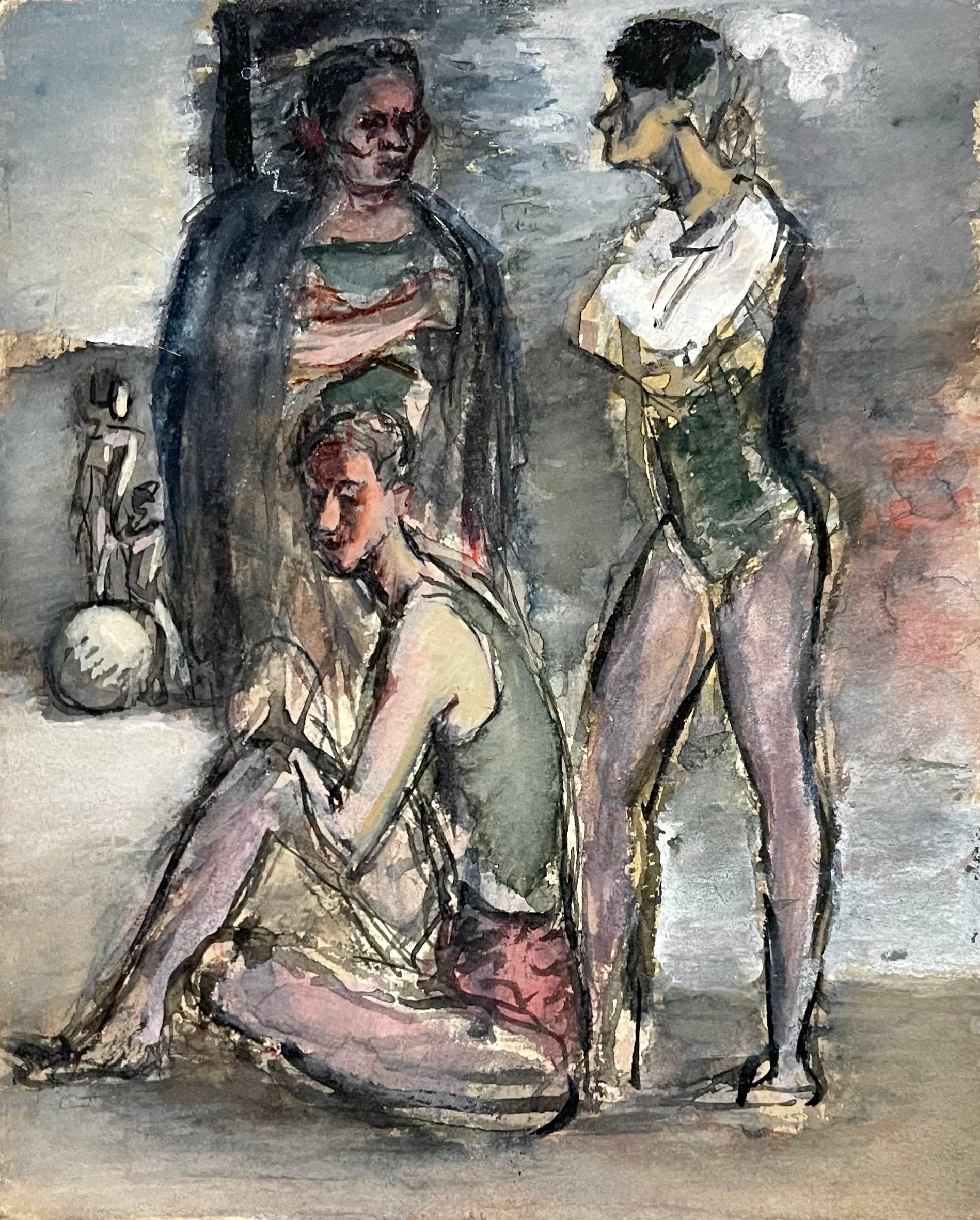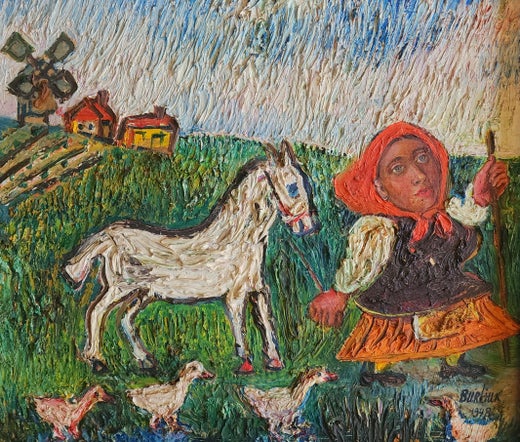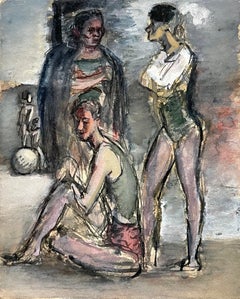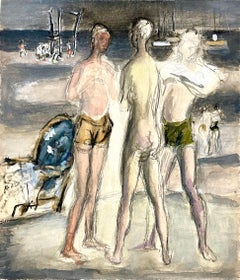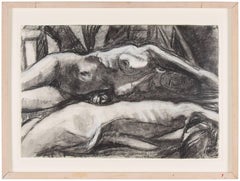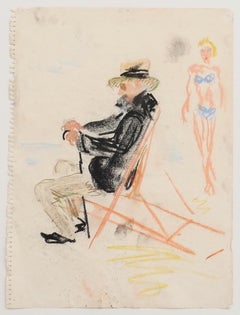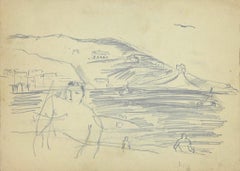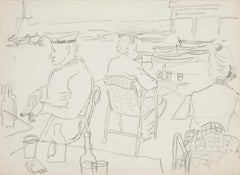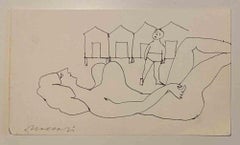Items Similar to Modernist Conte Crayon Drawing Beach Scene David Burliuk Russian Futurist
Want more images or videos?
Request additional images or videos from the seller
1 of 12
David BurliukModernist Conte Crayon Drawing Beach Scene David Burliuk Russian Futuristc.1940's
c.1940's
$1,500
£1,132.01
€1,295.98
CA$2,115.50
A$2,322.55
CHF 1,211.68
MX$28,106.12
NOK 15,186.53
SEK 14,309.71
DKK 9,674.14
About the Item
David Burliuk (Ukrainian, 1882-1967)
Three figure on the beach (Hamptons, Long Island New York)
Conte crayon drawing on paper.
Hand signed lower left.
Unframed
Provenance: Bloomsbury Auctions
David Davidovich Burliuk (Дави́д Дави́дович Бурлю́к; 1882-1967) was a Russian poet, artist and publicist of Ukrainian origin associated with the Futurist and Neo-Primitivist movements. Burliuk has been described as "the father of Russian Futurism."
David Burliuk was born on 21 July 1882 in the village of Riabushky (near Lebedyn, Ukraine) in the Kharkov Governorate of the Russian Empire. Burliuk's family was artistically inclined; two of his brothers were talented artists as well, Nikolai and Volodimir Burliuk. The Burliuk family partly descended from Ukrainian Cossacks on their father's side, who held premier positions in the Hetmanate. His mother, Ludmyla Mikhnevich, was of ethnic Belarusian descent.
From 1898 to 1904, he studied at Kazan and Odesa art schools, as well as at the Royal Academy in Munich. His exuberant, extroverted character was recognized by Anton Azhbe, his professor at the Munich Academy, who called Burliuk a "wonderful wild steppe horse". During a time of significant industrialization and political change, movements such as the famed Der Blaue Reiter, a group Burliuk associated with in 1912, while he was in Munich, emphasized a shift away from the classical styles of the past, prioritizing the innovations of the future.
In 1907, he made contact with the Russian art world; he met and befriended Mikhail Larionov, and they are both credited as being major forces in bringing together the contemporary art world. In 1908, an exhibition with the group Zveno ("The Link") in Kiev was organized by David Burliuk together with Wladimir Baranoff-Rossine, Alexander Bogomazov, his brother Volodymyr (Wladimir) Burliuk and Aleksandra Exter. The exhibition was a flop, especially because they were all unknown painters. The Burliuks and Larionov left for the aforementioned brothers' home in Chernianka, also known as Hylea; it was during this stay that their work became more Avant-Garde. That autumn, while visiting Ekster, they organized an exhibition which took place in the street; it was a success, and enough money was raised to go to Moscow.
In 1909, Burliuk painted a portrait of his future wife, Marussia, on a background of flowers and rocks on the Crimean coast.
The Futurist literary group Hylaea (Гилея [Gileya]) was initiated in 1910 by David Burlyuk and his brothers at their aforementioned estate near Kherson, and were quickly joined by Vasily Kamensky and Velimir Khlebnikov, with Aleksey Kruchenykh and Vladimir Mayakovsky joining in 1911. Soon afterwards, the group would morph into literary Cubism Futurism, the predominant form of Futurism in Russia.
From the start to the end, Cubist Futurism always had an air of scandal about it. The artists and poets scandalized the public by walking in public spaces wearing ridiculous clothes and painting their faces, by writing plays incomprehensible to the public. Alexander Rodchenko later claimed that a specific recital "was the first time I had seen such a frenzied, furious audience". Even during the First World War their activities carried on: at the 1915 Christmas Party, hosted by Lilya and Osip Brik, the tree was hung from the roof, upside-down, and the guests arrived with vegetables in their buttonholes and in bizarre makeup. Russian Futurism would only end after the Revolution of 1917.
Most of the Cubo-Futurists also resisted the Futurists in Italy. A brief alliance with their rivals, the Ego-Futurists, did not end very well. Burliuk's colleague Velimir Khlebnikov also developed Zaum, a poetry style.
From 1910, he was the member of the group Jack of Diamonds, and from 1910 to 1911 he attended the Art School in Odessa. After 1911, David concentrated on poetry and manifestoes, and at Christmas he made the acquaintance of Benedikt Livshits, a Jewish poet. From 1911 to 1913, he studied at the Moscow School of Painting, Sculpture and Architecture (MUZHVZ), and that year participated in the group exhibition of the Blaue Reiter in Munich, which also included his brother Wladimir. He also contributed an article to the Blaue Reiter Almanac.
In December 1912, Burliuk was co-author and one of the many signatories of the manifesto A Slap in the Face of Public Taste with the other members of Hylaea, one of the major manifestoes of Russian Futurism, a movement of Russian poets and artists who adopted the principles of Filippo Marinetti's "Futurist Manifesto".
In 1913, he was expelled from the Art Academy, as well as Mayakovsky. In the same year, Burliuk founded the publishing venture of the futurist writer's group Hylaea. In 1914, he and his brother Wladimir illustrated Kamensky's Tango with Cows, and in 1915 Burliuk published the book The Support of the Muses in Spring, with illustrations by Aristarkh Lentulov, and by David and Wladimir Burliuk.
From 1915 to 1917, he resided in the Urals with frequent trips to Moscow and Petrograd (St. Petersburg). In 1917, he participated in an exhibition with the group Jack of Diamonds in the artists' salon in Moscow, which included Aleksandra Ekster and Kazimir Malevich.
In 1916, his brother Wladimir Burliuk was drafted into military service, and in 1917 was killed in World War I in Saloniki. The next year, following the downfall of anarchism (he had befriended anarchists during the time he lived in an abandoned house), Burliuk fled Russia and began his journey to the United States, a process that took him through Siberia, Japan, and Canada which was not complete until 1922.[7] He kept in contact with his fellow Futurists in Russia, and, despite not knowing a word of English, managed to befriend artist and patron Katherine Dreier, establishing himself among the artists of that country. In 1922, he settled in the United States.
In 1924 Burliuk published two Radio-style manifestos detailing a utopian art that would transcend space-time and aid in humanity's pursuit of knowledge and perfection. A colossal sized painting from this period titled Advent of the Mechanical Man, 1925–26, was exhibited in the Brooklyn Museum's 1926 International Exhibition of Modern Art Assembled by Société Anonyme.
In New York, Burliuk developed activity in pro-Soviet oriented groups and, having written a poem for the 10th anniversary of the October Revolution, sought, in particular, to gain recognition as the "father of Russian futurism". He was a regular contributor to the Russian Voice newspaper. Burliuk published his collections, brochures, and magazines together with his wife Maria Nikiforovna, and through friends he distributed these publications mainly within the USSR.
In 1925, Burliuk was a co-founder of the Association of Revolutionary Masters of Ukraine (ARMU) with the members Alexander Bogomazov, Vasiliy Yermilov, Vadym Meller, Alexander Khvostenko-Khvostov, and Palmov Victor. In 1927, he participated in an exhibition of the Latest Artistic Trends in the Russian Museum in Leningrad (St. Petersburg), together with Kazimir Malevich, Aleksandr Shevchenko, and Vladimir Tatlin. Burliuk was author of autobiographical sketches My Ancestors, Forty Years: 1890–1930.
In the 1930s, Onya La Tour was an avid collector of modern art who acquired at least one hundred works by Burliuk. Like Ben Shahn, David Burliuk worked for the WPA. and developed a Social Realist style. His circle of friends at this time include Philip Evergood, Milton Avery, Stuart Davis, Nahum Tschacbasov, William Gropper, the Soyer brothers, Robert Gwathmey, Marsden Hartley, and Max Weber.
In 1940, Burliuk petitioned the Soviet government for a request to visit his homeland. In exchange, he offered a sizeable collection of archival material pertaining to his contemporary and friend Vladimir Mayakovsky, which Burliuk offered to donate to the Mayakovsky Museum in addition to over 100 original paintings. Burliuk's requests were denied. He was allowed to visit the Soviet Union only in 1956 and 1965.
In 1945, an exhibit was mounted at Irving Place Theater in New York City.
In 1962, he and his wife traveled to Australia where he held an exhibition at Moreton Galleries, Brisbane. It was his only Australian exhibition. During his stay there, Burliuk painted some sketches and works with Australian views. From 1937 to 1966, Burliuk and his wife, Marusia, published Color & Rhyme, a journal primarily concerned with charting Burliuk's activities.
Burliuk lived in Hampton Bays on Long Island for approximately 20 years until he died at Southampton Hospital in Southampton, New York. His house and studio still remain.
In Russian poetry, Burliuk is regarded as a trailblazer. In 1990, the Russian Academy of Futurist Poetry established the David Burliuk Prize (Otmetina) for experimental poetry awarded annually.
Burliuk appears in Part III of the Vladimir Mayakovsky's landmark poem A Cloud in Trousers (A Cloud in Pants, 1915).
A painting (most likely fictional) by Burliuk appears in the novel Chapayev and Void by Viktor Pelevin. The painting is described as a black writing though a stencil of the word GOD.
- Creator:David Burliuk (1882 - 1967, Ukrainian)
- Creation Year:c.1940's
- Dimensions:Height: 9 in (22.86 cm)Width: 12 in (30.48 cm)
- Medium:
- Movement & Style:
- Period:
- Condition:good. minor wear. please see photos This is being sold unframed.
- Gallery Location:Surfside, FL
- Reference Number:1stDibs: LU38214516772
David Burliuk
Considered the "Father of Russian Futurism" and one of the leading figures of the Modernist avant-garde, David Burliuk is experiencing an enormous resurgence of interest and critical attention forty years after his death. As painter, poet and writer of manifestos, Burliuk was a central figure in the intellectual and artistic avant-garde of early 20th century Russia. He was inspired by revolutionary Western European art movements ranging from Impressionism and Post-Impressionism to Fauvism, Cubism, German Expressionism, Italian Futurism and Symbolism, but also by the Orthodox religious icons and naive folk art of Russia and his birthplace, the Ukraine. Art movements to which he contributed include Russian Neo-Primitivism, an infusion of Fauvist color and Expressionist brushwork into landscapes and portraits inspired by folk art; Rayonism, a synthesis of Cubist configurations of space and Futurist representations of speed and dynamism; and Cubo-Futurism, a blend of Neo-Primitivist subjects and Cubist or Futurist style. Burliuk participated in the foundational exhibition of Moscow's influential "Jack of Diamonds" group in 1910 and also in its subsequent shows, together with not only Russian artists - Chagall, Kandinsky, and Malevich among others - but also foreign celebrities including Picasso, Matisse, Braque and Derain. He also exhibited in Munich in 1911 with the international Der Blaue Reiter group that included Kandinsky, Jawlensky, Franz Marc and Paul Klee, and contributed an essay to the first volume of the Blaue Reiter group's Almanac. Born in the Ukriane in 1882, he enjoyed access to a high degree of education, with periods of study in Kazan, Odessa, Munich, Paris, and Moscow. His participation in the avant-garde spirit of the times led to his expulsion from the Moscow School of Painting, Sculpture and Architecture in 1914. Burliuk fled Russia in 1918 during the Bolshevik revolution and spent the next four years in Siberia and then Japan. He was court painter to the Japanese emperor from 1920-1922 and very well received there. However, anticipating war with Russia, the Japanese government requested that he leave. He then immigrated to New York and developed his "Radio" style, a dynamic and innovative blend of Symbolism, Neo-Primitivism and Expressionism, so called in reference to the advent of radio and its ability to make available a variety of cultures. Burliuk's critical acceptance in the New World came in 1923 with a major exhibition of his paintings at the Brooklyn Museum and soon thereafter a solo show at the Société Anonyme - the first museum of experimental modern art - established in New York by Marcel Duchamp, Man Ray and Katherine Dreier. In 1939, after experiencing increasing success as a writer, editor and painter, he moved his family from the Lower East Side to Hampton Bays, Long Island. He traveled again to Europe which prompted a series of pictures inspired by Van Gogh and Pieter Brueghel the Younger. In addition to Cubo-Futurist and Symbolist paintings, he continued creating proto-naive paintings, depicting the American landscape as well as the Russian countryside.
About the Seller
4.9
Platinum Seller
Premium sellers with a 4.7+ rating and 24-hour response times
Established in 1995
1stDibs seller since 2014
1,810 sales on 1stDibs
Typical response time: 1 hour
- ShippingRetrieving quote...Shipping from: Surfside, FL
- Return Policy
Authenticity Guarantee
In the unlikely event there’s an issue with an item’s authenticity, contact us within 1 year for a full refund. DetailsMoney-Back Guarantee
If your item is not as described, is damaged in transit, or does not arrive, contact us within 7 days for a full refund. Details24-Hour Cancellation
You have a 24-hour grace period in which to reconsider your purchase, with no questions asked.Vetted Professional Sellers
Our world-class sellers must adhere to strict standards for service and quality, maintaining the integrity of our listings.Price-Match Guarantee
If you find that a seller listed the same item for a lower price elsewhere, we’ll match it.Trusted Global Delivery
Our best-in-class carrier network provides specialized shipping options worldwide, including custom delivery.More From This Seller
View AllSimka Simkhovitch WPA Artist Painting Gouache American Modernist Beach Scene
By Simka Simkhovitch
Located in Surfside, FL
Simka Simkhovitch (Russian/American 1893 - 1949)
This came with a small grouping from the artist's family, some were hand signed some were not.
These were studies for larger paintin...
Category
1930s American Modern Nude Paintings
Materials
Gouache, Board
Simka Simkhovitch WPA W/C Painting Gouache American Modernist Beach Scene Nude
By Simka Simkhovitch
Located in Surfside, FL
Simka Simkhovitch (Russian/American 1893 - 1949)
This came with a small grouping from the artist's family, some were hand signed some were not.
These were studies for larger paintin...
Category
1930s American Modern Nude Paintings
Materials
Gouache, Board, Watercolor
Beach Scene Pastel Drawing Polish Ecole D'Paris, WPA, Bezalel Artist
By Jacques (Jakub) Zucker
Located in Surfside, FL
Jacques Zucker was born in 1900 in Radom, Poland. He was a notably famous Jewish American artist mostly known for his expressionist figure paintings. In his young years he traveled t...
Category
20th Century Modern Landscape Photography
Materials
Pastel
Untitled (7) Figural Expressionist Nude Charcoal Drawing
By Steven Harvey
Located in Surfside, FL
Subject: Figures
Medium: Other, Charcoal
Surface: Paper
Country: United States
Dimensions w/Frame: 27 1/4" x 20 1/4"
without frame 15.25" X22.75"
EDUCATION
New York Studio School of Painting , Drawing & Sculpture 1973
Empire State College, B.A., Painting and Curatorial Studies 1999
ONE PERSON EXHIBITIONS
Mirrors, Gallery Schlesinger, New York, N.Y. 1999
Figures, Gallery Schlesinger, New York, N.Y. 1997
Sexual Monochromes, Gallery Schlesinger, New York, N.Y. 1992
"Paintings", 17th Street Gallery, New York, N.Y. 1976
SELECTED GROUP EXHIBITIONS
Family Line- drawings and paintings by Anne Harvey, Jason Harvey
and Steven Harvey, New York Studio School, New York, NY 2002
Steven Harvey- Paintings and Bruce Gagnier - Sculpture,
Gallery Schlesinger, New York, NY 2000
Woman, Gallery Schlesinger, New York, N.Y. 1999
Water and Light, Mary Gearhart Gallery, New York, N.Y. 1997
Contemporary Figures, M B Modern Gallery 1997
On Air, St. PeterÃs Church, N.Y. 1997
People , Places and Things: An Exploration of the Portrait, 1996-97
New York Studio School
Cafe El Maroc, Jamaica Arts Center 1994
Paintings, Schlesinger Gallery 1993
WFMU Benefit Auction, Germans Van Eck Gallery 1992
Night, Trenkmann Gallery 1991
ACT UP Benefit Auction, Paula Cooper Gallery 1990
Figuring Eros, Director's Annual, Snug Harbor
Cultural Center, Staten Island, N.Y. 1990
Erotic America, Galerie Antoine Candeau, Paris, France 1989
Of Another Nature, Loughelton Gallery, N.Y.C. 1988
New Territories in Art: Europe/America, curated by
Achille Bonito Oliva, Francavilla Al Mare, Italy 1987
Spatial FX, Annina Nosei Gallery 1987
Paint/Film, Bess Cutler Gallery 1987
Melancholy, Anne Plumb Gallery 1987
Group Invitational, Schlesinger Gallery 1986
Thought Objects, Cash/Newhouse Gallery 1985
Saloon/Salon, Bill Rice Gallery 1985
Steven Harvey has worked as an art advisor, art dealer, curator, and writer for over 25 years. He is the director of Steven Harvey Fine Art Projects in NYC, a gallery focused on contemporary painting, which he founded in 2007. SHFAP moved to the lower east side in 2011. It exhibits contemporary artists including Susanna Coffey, Kurt Knobelsdorf, Sangram Majumdar, Stuart Shils, Gideon Bok, Eleanor Ray...
Category
Early 2000s Neo-Expressionist Nude Drawings and Watercolors
Materials
Paper, Charcoal
American Modernist Oil Painting Nude Male on Beach WPA Artist Group of 10
By Ben-Zion Weinman
Located in Surfside, FL
Born in 1897, Ben-Zion Weinman celebrated his European Jewish heritage in his visual works as a sculptor, painter, and printmaker. Influenced by Spinoza, Knut Hamsun, and Wladyslaw Reymont, as well as Hebrew literature, Ben-Zion wrote poetry and essays that, like his visual work, attempt to reveal the deep “connection between man and the divine, and between man and earth.”
An emigrant from the Ukraine, he came to the US in 1920. He wrote fairy tales and poems in Hebrew under the name Benzion Weinman, but when he began painting he dropped his last name and hyphenated his first, saying an artist needed only one name.
Ben-Zion was a founding member of “The Ten: An Independent Group” The Ten” a 1930’s avant-garde group, Painted on anything handy. Ben-Zion often used cabinet...
Category
Mid-20th Century Expressionist Figurative Paintings
Materials
Oil, Board
Modernist Beach Scene Painting, Playing Ball in Surf, WPA Jewish Woman Artist
By Ruth Gikow
Located in Surfside, FL
Modernist beach scene; signed lower right; image size is 11.5 x 8.5 inches, framed it measures
Ruth Gikow (January 6, 1915 Ukraine - 1982 New York City) was an Important American Jewish woman visual artist known primarily for her work as a genre painter. Her paintings often depict human figures interacting with an urban environment.
Ruth Gikow was born in 1915 in the Ukraine. Her father, Boris, was a photographer and her mother was named Lena. In 1920 she emigrated to New York City due to civil war and pogroms against the Jewish community. The pilgrimage took around two years. Once in New York City, the Gikow family found themselves in poverty, rather than the middle-class comfort they enjoyed in Ukraine. Ruth Gikow's skill was prominent even in youth, as she excelled in drawing in elementary school and entered Washington Irving High School at age thirteen in which she furthered her art prowess.
Later, she studied at the Cooper Union Art School, where she studied under school director Austin Purvis, Jr. and regional artist John Steuart Curry. In her second year of Art School, she was awarded a scholarship which she used to work with fellow painter Raphael Soyer.
She joined the New York City WPA Federal Art Project in 1935, where she was allowed to dedicate herself to her artwork full-time. In 1939, inspired by the muralists Diego Rivera and José Clemente Orozco, she applied and later won a commission to paint murals for Bronx Hospital, Rockefeller Center and the New York World's Fair. After the events of Pearl Harbor and once the Federal Arts Project was abandoned, Gikow's murals were sought after by New York department stores wishing to commission wall paintings. Gikow became disillusioned with mural painting due to the commercial aspect of these commissions.
With other associates, she founded the American Serigraph Society (along with Anthony Velonis, Lena Gurr, Robert Gwathmey, Leonard Pytlak, Harry Shoulberg, Russell Twiggs...
Category
1960s American Modern Figurative Paintings
Materials
Paint, Paper
You May Also Like
At the Beach - Original Pastel - Mid-20th Century
Located in Roma, IT
At the Beach is an original drawing in pastel on creamy paper, realized by an Anonymous artist of the mid-20th Century.
The state of preservation of the artwork is good with some f...
Category
Mid-20th Century Modern Figurative Prints
Materials
Pastel
From the beach - Original Pencil by Herta Hausmann - Mid-20th century
Located in Roma, IT
From the beach is a pencil drawing by Herta Hausmann.
Good conditions and atelier stamp on the back of the brown paper.
Category
Mid-20th Century Modern Figurative Drawings and Watercolors
Materials
Pencil
On the Beach - Pencil on Paper - 20th Century
Located in Roma, IT
On the Beach is a drawing in pencil on paper realized by an Anonymous artist of the 20th century.
The State of preservation is very good.
The artwork represents the scenery of fig...
Category
20th Century Figurative Drawings and Watercolors
Materials
Pencil
At the Beach - Drawing by Mino Maccari - Mid-20th Century
By Mino Maccari
Located in Roma, IT
At the Beach is a Pen Drawing realized by Mino Maccari (1924-1989) in the Mid-20th Century.
Hand-signed on the lower.
Good conditions.
Mino Maccari (Siena, 1924-Rome, June 16, 19...
Category
Mid-20th Century Modern Figurative Drawings and Watercolors
Materials
Pen
German expressionist drawing of bathers by Carl Hofer 'Die Badegasten'
By Carl Hofer
Located in Petworth, West Sussex
Carl Hofer (German, 1875 – 1955)
Die Badegaste II (The bathers)
Black crayon on paper
19.1/4 x 15 in. (49 x 38 cm.)
With studio stamp (on the reverse) and signature of the artist’s wife Elizabeth Hofer
Provenance: These works come from the artist’s second wife Elizabeth and from then by descent.
Carl Hofer was a German expressionist painter and the director of the Berlin Academy of Fine Arts. One of the most important painters of the Expressionist movement, his work was among those that was considered degenerate art by the Nazis. He studied in Karlsruhe under Hans Thoma. He first visited Paris in 1899 making acquaintance with Julius Meier-Graefe. In 1902 he studied in Stuttgardt and became friends with the sculptor Hermann Haller...
Category
20th Century Expressionist Figurative Drawings and Watercolors
Materials
Paper, Crayon
At the Seaside - Drawing by Sirio Pellegrini - 1960s
Located in Roma, IT
Oil pastel and watercolor on cardboard realized by Sirio Pellegrini in 1960s.
Includes a wooden frame realized by the Artist. cm. 157.5x113.5.
Sirio Pellegrini, born in Rome on Mar...
Category
1960s Contemporary Figurative Drawings and Watercolors
Materials
Cardboard, Oil Pastel
More Ways To Browse
Retro Futurism
Mid Century Beach Scene Painting
Bizarre Vintage
Abandoned House
Blaue Reiter
Der Blaue Reiter
Homer Brothers
Filippo Marinetti
Milton Davis
Mid Century Walking Man Sculpture
The Mother Of God Of Kazan
Katherine Curci
King Charles Watercolour
Painting Blanche American
Pencil Drawings Of Flowers
S Warren Art
Vibert Jehan Georges
Wes Lang
